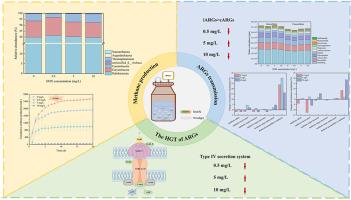The effect of sulfamethoxazole on methanogenesis and intracellular and extracellular antibiotic resistant genes transmission in anaerobic granular sludge
IF 7.7
2区 环境科学与生态学
Q1 ENVIRONMENTAL SCIENCES
引用次数: 0
Abstract
Anaerobic granular sludge has been extensively utilized in anaerobic wastewater treatment due to its stable structure and strong resistance to shock loads. However, the mechanisms by which varying concentrations of sulfamethoxazole (SMX) influence methane production, as well as the transmission of intracellular and extracellular antibiotic resistance genes (ARGs), remain unclear. This study investigated the effects of SMX concentration on methane production and intracellular and extracellular ARGs transfer behavior during anaerobic wastewater treatment. Results showed that the final methane yield was 333.2, 470.1, 199.1, and 7.2 mL/gCOD, respectively, under 0, 0.5, 5, and 10 mg/L SMX. 0.5 mg/L SMX enhanced methane yield by 41.1 %. This enhancement was attributed to the stimulation of extracellular polymeric substances and catalase secretion, which alleviated oxidative stress caused by reactive oxygen species and increased the abundance of Methanosaeta and Methanobacterium. Simultaneously, the spread of both intracellular and extracellular ARGs was suppressed through the regulation of host microbial communities, specifically reflected in the reduced abundance of ARGs, decreased abundance of cell membrane permeability genes and the type IV secretion system. In contrast, 5 and 10 mg/L SMX inhibited methane production while facilitating ARGs dissemination. This study demonstrated that SMX concentrations significantly affected methane production and the prevalence of ARGs during anaerobic wastewater treatment.

磺胺甲恶唑对厌氧颗粒污泥中甲烷生成及细胞内外抗生素耐药基因传播的影响。
厌氧颗粒污泥因其结构稳定,抗冲击负荷能力强,在厌氧废水处理中得到了广泛的应用。然而,不同浓度的磺胺甲恶唑(SMX)影响甲烷产生以及细胞内和细胞外抗生素耐药基因(ARGs)传播的机制尚不清楚。本研究考察了厌氧废水处理过程中SMX浓度对甲烷产量和胞内胞外ARGs转移行为的影响。结果表明,当SMX浓度为0、0.5、5和10 mg/L时,最终甲烷产率分别为333.2、470.1、199.1和7.2 mL/gCOD。0.5 mg/L SMX使甲烷产率提高41.1%。这种增强是由于细胞外聚合物质和过氧化氢酶的分泌受到刺激,减轻了活性氧引起的氧化应激,增加了甲烷菌和甲烷杆菌的丰度。同时,通过调控宿主微生物群落,抑制胞内胞外ARGs的传播,具体表现为ARGs丰度降低,细胞膜通透性基因丰度降低,IV型分泌系统减少。相比之下,5和10 mg/L SMX抑制甲烷的产生,同时促进ARGs的扩散。本研究表明,SMX浓度显著影响厌氧废水处理过程中甲烷产量和ARGs的发生率。
本文章由计算机程序翻译,如有差异,请以英文原文为准。
求助全文
约1分钟内获得全文
求助全文
来源期刊

Environmental Research
环境科学-公共卫生、环境卫生与职业卫生
CiteScore
12.60
自引率
8.40%
发文量
2480
审稿时长
4.7 months
期刊介绍:
The Environmental Research journal presents a broad range of interdisciplinary research, focused on addressing worldwide environmental concerns and featuring innovative findings. Our publication strives to explore relevant anthropogenic issues across various environmental sectors, showcasing practical applications in real-life settings.
 求助内容:
求助内容: 应助结果提醒方式:
应助结果提醒方式:


